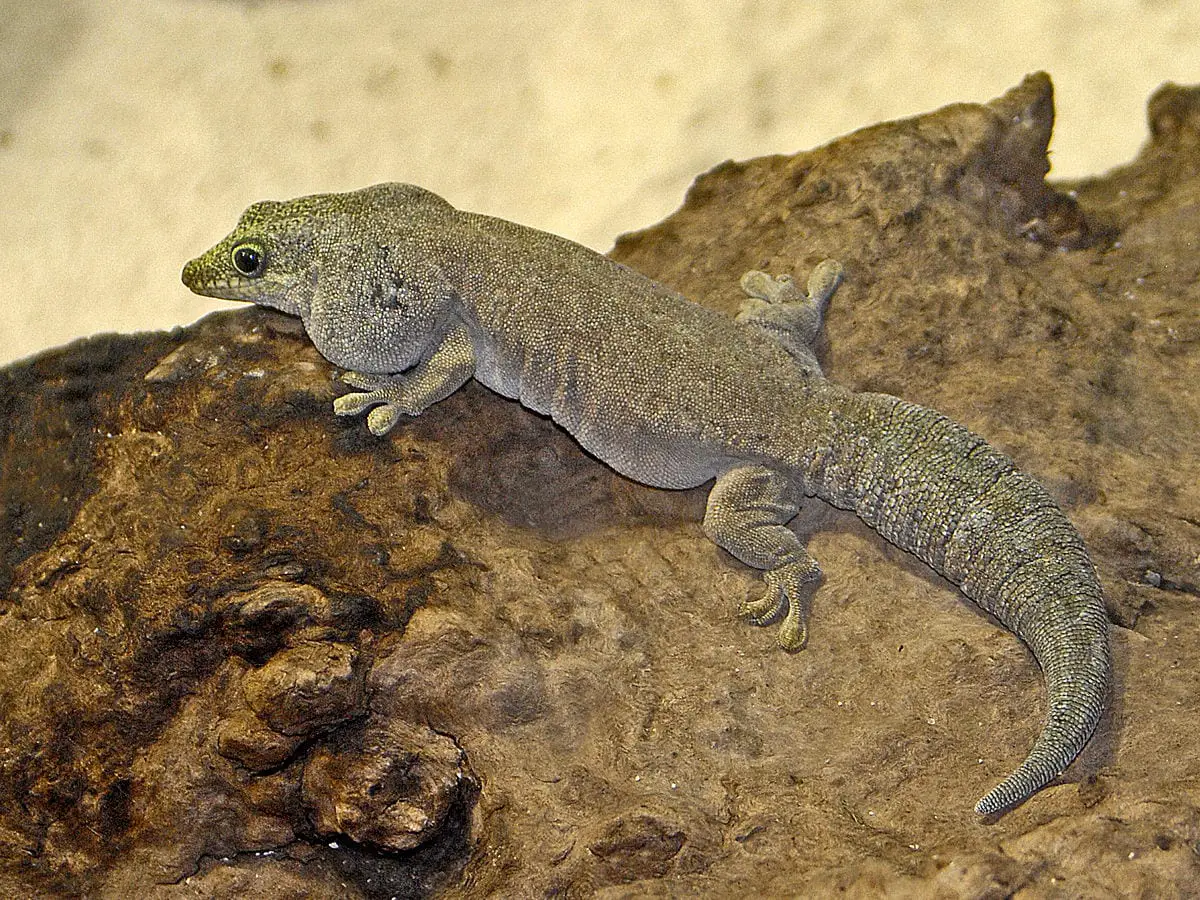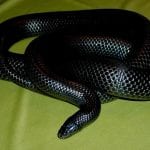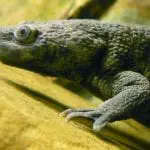Scientific Facts
| Common Name: | Standing’s Day Gecko |
| Scientific Name: | Phelsuma Standingi |
| Life Span: | 8 to 12 years |
| Length / Size: | 8 inches to 11 inches |
| Habitat: | Arid areas, tops of trees |
| Country of Origin: | Madagascar |
Physical Description
The Standing’s Day Geckos, who come from Madagascar, are distinguished for being larger compared to other species of geckos. They are also known for their unique colorations and beautiful patterns. The mature ones are usually dressed with green tones mixed with a purple and gray base color throughout their heads and bodies. For their tails, a blue tint can be seen in them.
Also, compared to other species in the Phelsuma family, the Standing’s day geckos have thicker skin that is not prone to tearing because they reside in a drier area of Madagascar. The Standing’s day geckos can grow as long as 11 inches, but the average length is 8 inches.
Conservation Status
According to the IUCN’s Red List, the Standing’s Day Gecko is a species that has reached Vulnerable status, nearing being endangered. There was a big number of these species that were exported in the 1990s. This was mainly because they are friendly animals and they are also very colorful.
The major problem that this species has faced is they experienced an extensive loss in their natural habitat. There are more and more settlements used by humans, forests being cleared, and herds of zebu grazing their habitat. Predators like snakes and birds pose a threat against them as well.
Life Span
As long as they live in ideal conditions, the Standing’s day geckos can live an average of 10 years in captivity, or even much longer.
Availability and Natural Habitat
The Standing’s Day Gecko is restrictedly available towards the dry areas of Andranolaho, Sakahara, and Zombitse-Vohibasia National Park on Southwestern Madagascar.
Behavior
The Standing’s day geckos are known for being monogamists and mating for life. They are also not known for being social beings, and they can bond quite intensely with other species. They also love spending time on tops of trees and basking in the sun on the well-exposed branches. Males are usually territorial against other males, while the females feel territorial and fight other females.
Diet and Eating Habits
When they are living in the wild, Standing’s day geckos usually eat what is usually available in their surroundings. Normally, this includes medium to large roaches, hornworms, silkworms, reptiworms, waxworms, mealworms, and crickets.
In captivity, as much as you can, you should try to add variety to your pet gecko’s diet so that it can receive the different nutrients that it needs. If you cannot provide it, the large variations of small animals that it wants to it, use some food supplements, high-quality reptile calcium D3 supplement, and reptile multivitamins are the most recommended meal additions. For females who would be laying eggs, they should be fed calcium supplements daily.
If you cannot find some fresh worms and insects, there are commercially available ready-made gecko diet meals. These are treats that are packed with nutrients that your pet day gecko needs.
Development and Reproduction
For these reptiles, mating seasons usually happen every December to March, when it is rainy. The Standing’s Day Gecko is an oviparous animal, which means that they lay eggs with very little or almost no assisted development from the mother. After successful mating sessions, the female will usually lay two round eggs after six weeks. In one mating season, females can lay up to 12 eggs.
The eggs when lain hatch approximately after 2 months up to 70 days. The hatchling measures around 80 mm, but after just a year, they will experience sexual maturity.
Handling
Though you might be attracted by the beautiful colors of the Standing’s day gecko, you should refrain from handling them as much as you can, as it is not really recommended by experts. But, these species of geckos love interacting with different species, so they can actually get used to interacting with humans and being hand tame. You have to remember, though, that you should think about your pet’s comfort at all times, and limiting handling sessions might be the overall best thing to avoid injury and stress.
Caging
Standing’s Day Geckos are known for being very active, so you should provide them with an enormous enclosure that can allow them to move freely. If you plan on taking care of a couple of them, so you can breed your own geckos, you should be able to provide 18 inches by 18 inches by 24 inches of cage space. Additionally, these geckos are great for placing on display, and you can even use larger cages to showcase them.
When designing a cage for your pet day gecko, you should look into how the animal usually behaves. Though they tend to be larger compared to other geckos, they are still much smaller, and they are often being treated like prey. Because of this, these geckos love hiding places, whether they are horizontal or vertical basking locations.
Because the Standing’s day gecko loves climbing, keepers should make the most of this by providing lots of vertical hiding places. Most owners use some bamboo hollows for this. You can also use some cork flats, cork rounds, wood products, magnetic ledges, and grapevines for visually interesting décor that also doubles as a hiding place for your pet.
If you are debating on whether you would prefer adding some foliage in the vivarium, here are some reasons why you should. Live plants are very aesthetically pleasing, and they also increase the humidity in the enclosure. This provides a microclimate that will benefit the health of your pet gecko. You need not worry about the gecko eating the leaves, and you can be free to install any form of plant that you would prefer.
Substrate
For Standing’s day geckos, the substrates generally depend on what type of living space you want to set up. If you are going for a vivarium with lots of live plants, you will be able to mimic the natural habitat of your pet gecko. For this kind of living area, you can use polyfoam, hydroton balls, and eco earth or moss. Polyfoam will serve as a divider between the planting layers and your drainage. Hydroton balls will be used for the cage’s drainage. Lastly, the eco earth or moss will be a great soil mixture for the living plants inside the vivarium.
If you would be going for an enclosure with artificial plants, you can use coconut husks, eco earth, orchid bark, and cypress mulch as your cage substrate. You can alternate the use of these depending on the month, so you can study which one you like the best.
Lighting and Heating
Standing’s day geckos are blessed with beautiful hues, but this can only be achieved if they receive the ample amounts of hot, bright lights that they need. Without the lighting and heat that they need, all their pretty colors will become dark and drab. Now, considering all of these, you can start with lighting the cage in various ways, mostly dependent on your budget.
First and foremost, you can opt with using fluorescent strip lighting and a basking light. This is one of the best ways to go, especially for spreading heat and warmth. For their basking areas, the temperatures must be set to 90 degrees Fahrenheit, while on the cool areas, you should set the temperature to around 70 degrees Fahrenheit. These temperatures will be perfect for younger geckos.
Alternately, if you have larger terrariums, you can use mercury vapor bulbs because they produce lots of heat and the much-needed UVB lights. Under these lights, you will be surprised to see their brightest and most vibrant colors.
If you are a hardcore keeper, look into lighting for experts and use some light systems. You can opt for metal halide bulbs and sodium halide lights to develop the absolute best color in your Standing’s day geckos. But these are very hot and very large, so before anything else, you should do extensive research to do things the right way.
Humidity and Water
Standing’s Day Geckos can survive with dry conditions as they are used to arid locations, but if you place them in a tropical set up or mildly humid area, they wouldn’t mind that, too. Also, you should make it a habit to mist your gecko and its cage with unchlorinated water at least twice a day. This is done to boost the humidity in the enclosure as well as providing some water droplets that can be drunk by your pet.
Though this might not be regularly used by your day gecko, it would be better if you place a bowl with regularly replenished freshwater should they want to soak in it.
Additionally, you can also use a terrarium fogger in the enclosure to increase humidity the natural way. The fog produced will allow condensation to be produced in the leaves of the plants inside the enclosure.
Fun Facts about Standing’s Day Gecko
- Standing’s Day Geckos get their name from Dr. Herbert F. Standing, a physician from Antananarivo, Madagascar.
- The generic name of this gecko, which is Phelsuma, is taken from the last name of Dr. Murk van Phelsum, a Dutch Physician.
- These geckos usually live in spiny forests, stone houses, and wooden huts.
- The Standing’s day geckos were discovered by John Hewitt and Paul Ashyford Methuen, two British zoologists, in 1913.
- Aside from eating insects, these animals also enjoy feeding on nectar.
- These geckos are called arboreal, which means they enjoy spending time above ground and hanging in trees.
- The color of the gecko’s body depends on their age and the light intensity of the place where they are spending time.
- The colors of the Standing’s day gecko can range from brown, grey, bright green, turquoise, yellow-green, and dark gray.
Where Can You Get a Pet Standing’s Day Gecko?
Standing day geckos have a smaller population count, but they can still be kept as pets. You can acquire them from licensed breeders and exotic pet sellers.
How to Care for a Pet Standing’s Day Gecko?
Here are some tips on taking care of pet Standing’s Day Gecko:
- Pet geckos can get stressed, too, so make sure that they have plenty of space to move around, and most especially, hide.
- Having a vivarium with increased sizes gives them the freedom to move around, and this is something essential for them to stay healthy.
- The Standing’s day geckos can tend to defecate toward the glass of their cages, so regularly use warm water and soap to clean this.
- They appreciate being held, and they have the knowledge to remember when and how feeding occurs. Be careful not to lose this trust and practice the utmost care when dealing with your pet gecko.
- Don’t forget to mist the enclosure every day to give your pet gecko plenty of water to drink.
Frequently Asked Questions
What are day geckos?
Day geckos are species of geckos that are diurnal, meaning they are active during the day.
Can you hold Standing’s day geckos?
It is not recommended to handle this species of geckos, because it might cause them discomfort and injure their skins. They may like it, though, because they enjoy being tamed, but this should not be done regularly.
Do Standing’s day geckos shed their skin?
The day geckos shed their skin, and they will not encounter problems as long as the humidity levels in their homes are at the right levels. Do not be worried if they eat their shed skin, as their skin is filled with nutrients.
Can Standing’s day geckos change their color?
Day geckos change their color depending on their age, mood, and the lighting or temperature in their current location.
Can day gecko’s hear?
Day geckos are equipped with unique hearing skills that can even detect the shrillest of sounds, with higher decibels that are not detected by humans.



